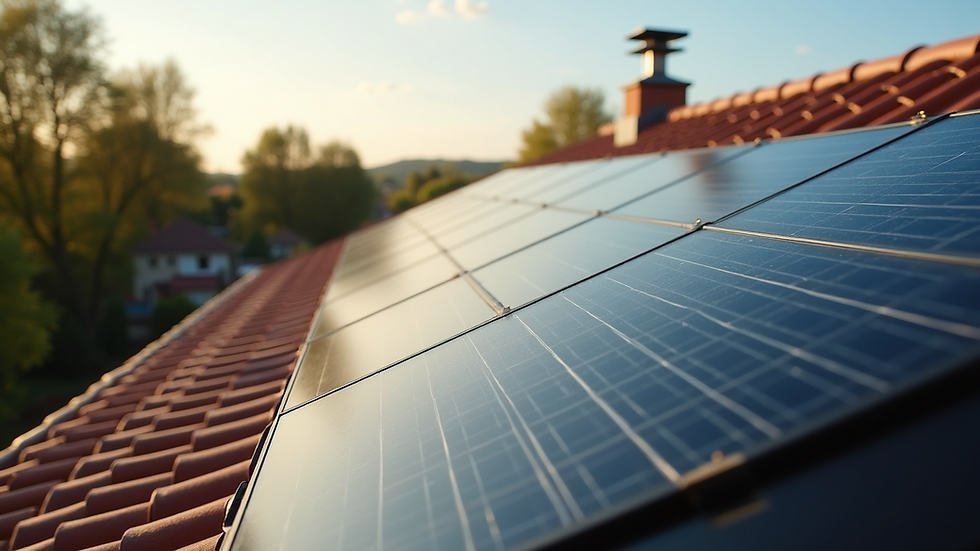The Essential Guide to Understanding a 6.6kW Solar System for Australian Homes
- Bill Adams
- Aug 15
- 4 min read
In recent years, solar energy has gained remarkable traction in Australia, thanks to its abundance of sunlight and the growing awareness of environmental sustainability. One of the most popular options for residential solar energy is the 6.6kW solar system. This guide aims to provide a comprehensive understanding of this solar system, including its benefits, components, financial implications, installation processes, and maintenance aspects.
What is a 6.6kW Solar System?
A 6.6kW solar system refers to a solar photovoltaic (PV) system that can generate up to 6.6 kilowatts of electricity at peak performance. Typically, this system consists of solar panels, an inverter, and mounting equipment. It’s designed to cater to the average energy consumption of Australian households, especially in urban settings.
This size of solar systems is particularly appealing because it strikes a balance between efficiency, cost-effectiveness, and the ability to meet typical household energy demands without overwhelming initial costs.
The Components of a 6.6kW Solar System
Solar Panels
The solar panels are arguably the heart of any solar system. A 6.6kW system usually comprises about 18 to 24 panels, depending on the wattage of each individual panel (generally between 300 to 370 watts). These panels convert sunlight into electricity, which can be used in your home or fed back into the grid.
Inverter
The inverter plays a crucial role by converting the direct current (DC) electricity generated by the solar panels into alternating current (AC) electricity, which is the type of electricity used in most households.
Mounting Equipment
The mounting equipment secures the solar panels to your roof or ground location. The design and quality of the mounting system are essential for ensuring the longevity and stability of the solar setup.
Benefits of a 6.6kW Solar System
Cost Savings
Switching to solar energy can significantly reduce your electricity bills. By generating your own electricity, you rely less on the grid, which can lead to savings over time. Many Australian households have reported reductions of 50-80% in their electricity costs after installing a solar system.
Environmental Impact
Utilizing solar energy contributes to reducing carbon emissions. By choosing renewable energy sources like solar, homeowners can play a part in combating climate change and promoting environmental sustainability.
Energy Independence
A 6.6kW solar system empowers homeowners to take control of their energy sources. On sunny days, you could generate more electricity than you need, allowing you to store or sell excess power back to the grid, thereby increasing your energy independence.
Financial Considerations
Initial Costs
Investing in a solar system involves upfront costs, which can range from $4,000 to $10,000 depending on the quality and brand of equipment. Government incentives, such as the Small-scale Renewable Energy Scheme (SRES), can significantly lower the initial investment.
Return on Investment
Most homeowners find that their solar system pays for itself within a relatively short time frame, typically between 3 to 7 years, largely dependent on local energy rates, the size of the system, and energy consumption.
Incentives and Rebates
In Australia, various government initiatives and rebates are available to support homeowners in their transition to solar energy. It’s essential to research potential incentives in your state to maximize financial savings.
Installation Process
Site Assessment
Before installation, a qualified solar installer will assess your property. Factors like roof orientation, inclination, and shading from trees or buildings will be considered to maximize the system’s efficiency.
Installation
The actual installation process typically takes 1 to 3 days. Installers will mount the solar panels, set up the inverter, and connect the system to your home’s electrical network.
Connection to the Grid
After installation, the final step involves notifying your energy provider and registering the system. This process is crucial for homeowners who intend to sell excess power back to the grid.
Maintenance of Your Solar System
Routine Checks
To keep your solar panels functioning at their best, periodic inspections can help identify any shading issues, dirt accumulation, or damages. Generally, cleaning the panels once or twice a year is recommended.
Monitoring Systems
Many solar systems come equipped with monitoring software that enables you to track energy production over time. This information can help homeowners identify any drops in efficiency.
Common Misconceptions
Performance in Cloudy Weather
Many people believe solar panels are ineffective on cloudy days. While it's true that the efficiency drops, solar panels can still produce energy even in overcast conditions, making them a viable option throughout the year.
Battery Storage is Mandatory
While battery storage is beneficial, it is not a requirement for solar energy systems. A 6.6kW solar system can effectively function without batteries by utilizing grid connection for energy consumption.
Conclusion
A 6.6kW solar system represents a smart investment for Australian homeowners looking to embrace renewable energy solutions. With its numerous benefits—including cost savings, environmental sustainability, and energy independence—it's clear why so many are making the switch.
Understanding the components, installation process, and maintenance needs is crucial for maximizing the benefits of a solar system. Whether you’re motivated by financial savings or a desire to contribute to a greener planet, investing in a solar energy system can provide both immediate and long-term rewards.
In a world increasingly demanding sustainable practices, adopting a solar system not only makes financial sense but is also a proactive step towards a cleaner, more sustainable future.





Comments